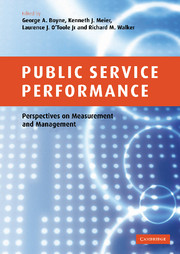Book contents
- Frontmatter
- Contents
- List of figures
- List of tables
- Notes on contributors
- 1 Introduction
- 2 Subjective and objective measures of organizational performance: An empirical exploration
- 3 All measures of performance are subjective: More evidence on US federal agencies
- 4 A qualitative evaluation of public sector organizations: Assessing organizational performance in healthcare
- 5 Quantitative approaches towards assessing organizational performance
- 6 Consequences of goal ambiguity in public organizations
- 7 Performance control and public organizations
- 8 Bureaucratic red tape and organizational performance: Testing the moderating role of culture and political support
- 9 All that glitters is not gold: Disaggregating networks and the impact on performance
- 10 Network evolution and performance under public contracting for mental health services
- 11 The design and management of performance-based contracts for public welfare services
- 12 Outsourcing government information technology services: An Australian case study
- 13 International comparisons of output and productivity in public service provision: A review
- 14 Public management and government performance: An international review
- 15 What drives global e-government? An exploratory assessment of existing e-government performance measures
- 16 Public management and organizational performance: An agenda for research
- Index
- References
14 - Public management and government performance: An international review
Published online by Cambridge University Press: 22 September 2009
- Frontmatter
- Contents
- List of figures
- List of tables
- Notes on contributors
- 1 Introduction
- 2 Subjective and objective measures of organizational performance: An empirical exploration
- 3 All measures of performance are subjective: More evidence on US federal agencies
- 4 A qualitative evaluation of public sector organizations: Assessing organizational performance in healthcare
- 5 Quantitative approaches towards assessing organizational performance
- 6 Consequences of goal ambiguity in public organizations
- 7 Performance control and public organizations
- 8 Bureaucratic red tape and organizational performance: Testing the moderating role of culture and political support
- 9 All that glitters is not gold: Disaggregating networks and the impact on performance
- 10 Network evolution and performance under public contracting for mental health services
- 11 The design and management of performance-based contracts for public welfare services
- 12 Outsourcing government information technology services: An Australian case study
- 13 International comparisons of output and productivity in public service provision: A review
- 14 Public management and government performance: An international review
- 15 What drives global e-government? An exploratory assessment of existing e-government performance measures
- 16 Public management and organizational performance: An agenda for research
- Index
- References
Summary
Introduction
Performance is seemingly an obsession with governments around the world. As Frederickson and Smith (2003: 208) point out, ‘[a]ccountability for conducting the public's business is increasingly about performance rather than discharging a specific policy goal within the confines of the law.’
Evidence for ‘this general advocacy of a performance orientation’ (Pollitt and Bouckaert 2004: 126) is found, for example, in the European Commission's commitment to ‘more efficient, performance-orientated working methods’ (EC 2000: 8), in the British government's widespread use of performance targets (James 2001) and in US President George W. Bush's ‘management agenda’ in particular, in the Office of Management and Budget (OMB) Program Assessment Rating Tool (PART), instituted in 2002. This tool represents the most recent effort by the US federal government to increase the emphasis on performance in government programmes and agencies, although the 1993 Government Performance and Results Act remains in effect. It was implemented by the Bush Administration as an explicit accountability strategy:
The PART was developed to assess and improve program performance so that the Federal government can achieve better results. A PART review helps identify a program's strengths and weaknesses to inform funding and management decisions aimed at making the program more effective. The PART therefore looks at all factors that affect and reflect program performance including program purpose and design; performance measurement, evaluations, and strategic planning; program management; and program results. Because the PART includes a consistent series of analytical questions, it allows programs to show improvements over time, and allows comparisons between similar programs.
(US OMB, 2005)- Type
- Chapter
- Information
- Public Service PerformancePerspectives on Measurement and Management, pp. 254 - 274Publisher: Cambridge University PressPrint publication year: 2006
References
- 14
- Cited by

